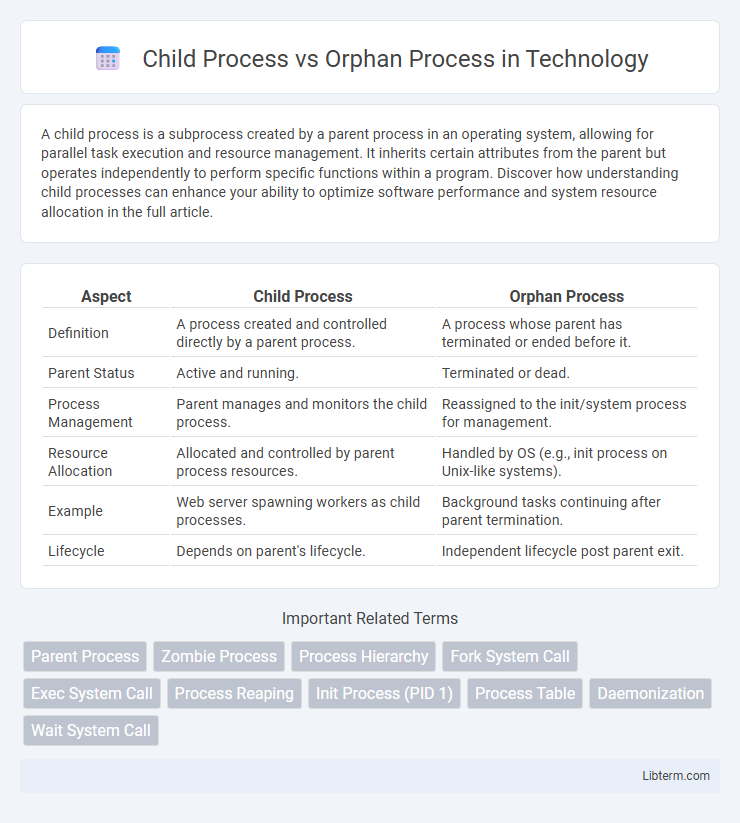A child process is a subprocess created by a parent process in an operating system, allowing for parallel task execution and resource management. It inherits certain attributes from the parent but operates independently to perform specific functions within a program. Discover how understanding child processes can enhance your ability to optimize software performance and system resource allocation in the full article.
Table of Comparison
| Aspect | Child Process | Orphan Process |
|---|---|---|
| Definition | A process created and controlled directly by a parent process. | A process whose parent has terminated or ended before it. |
| Parent Status | Active and running. | Terminated or dead. |
| Process Management | Parent manages and monitors the child process. | Reassigned to the init/system process for management. |
| Resource Allocation | Allocated and controlled by parent process resources. | Handled by OS (e.g., init process on Unix-like systems). |
| Example | Web server spawning workers as child processes. | Background tasks continuing after parent termination. |
| Lifecycle | Depends on parent's lifecycle. | Independent lifecycle post parent exit. |
Introduction to Process Management
Child processes are created by parent processes during execution and inherit certain resources, enabling concurrent task management and efficient CPU utilization. Orphan processes occur when a parent process terminates before its child processes, causing the operating system to reassign these orphans to a special process like init or systemd for proper handling. Effective process management requires handling child and orphan processes to ensure resource allocation, avoid process leakage, and maintain system stability.
Defining Child Processes
A child process is a subprocess created by a parent process during execution, inheriting attributes such as process ID and environment variables. It executes independently but remains linked to the parent, relying on it for resource management and termination signals. Child processes are fundamental in multitasking operating systems for efficient task delegation and parallel execution.
What Are Orphan Processes?
Orphan processes occur when a child process continues running after its parent process has terminated, resulting in the operating system reassigning the orphan to the init process (PID 1). These processes remain active and consume system resources until they also complete or are terminated. Managing orphan processes is crucial to prevent resource leaks and maintain system stability.
Key Differences: Child vs Orphan Processes
Child processes are created by a parent process and inherit resources such as file descriptors and environment variables, whereas orphan processes result when a parent process terminates before its child, causing the child to be reparented to the init process. Child processes typically run concurrently with the parent and are managed directly by it, while orphan processes continue execution independently under system supervision to prevent premature termination. Key differences include the origin of creation, resource inheritance, and process management responsibilities by the operating system.
Parent-Child Process Relationship Explained
A child process is created by a parent process and inherits resources such as file descriptors and environment variables, maintaining a direct and controlled parent-child process relationship. If the parent process terminates before the child, the child becomes an orphan process, which is then adopted by the init process (PID 1) to ensure system stability. This adoption mechanism prevents orphan processes from becoming defunct and manages process lifecycles efficiently within the operating system.
How Orphan Processes Are Created
Orphan processes are created when a parent process terminates before its child processes complete execution, leaving the child processes without a parent. In Unix-like operating systems, these orphan processes are automatically adopted by the init process (PID 1), ensuring system stability. This adoption prevents orphan processes from becoming zombie processes and allows them to continue running until they finish.
Reaping and Handling Orphan Processes
Child processes become orphaned when their parent process terminates prematurely, requiring the init process (PID 1) to adopt and manage them. Reaping involves the parent process using the wait() system call to collect the child's exit status, preventing zombie processes and freeing system resources. Proper handling of orphan processes ensures system stability by allowing the init process to reap them automatically and avoid resource leaks.
Impacts of Orphan Processes on System Performance
Orphan processes occur when a child process continues running after its parent process terminates, leading to system resource wastage and increased memory consumption. These processes often become defunct or zombie processes, consuming process table entries and potentially causing process ID exhaustion. Prolonged presence of orphan processes degrades system performance by increasing CPU load and complicating process management.
Security Implications: Child vs Orphan Processes
Child processes inherit the security context and permissions of their parent process, which can expose vulnerabilities if the parent is compromised or lacks proper access controls. Orphan processes, reassigned to the init system (PID 1), often run with more restricted privileges, reducing the risk of unauthorized access but potentially complicating resource management and monitoring. Ensuring strict permission boundaries and monitoring for orphaned processes is critical to maintaining system security and preventing privilege escalation.
Best Practices for Managing Processes in Operating Systems
Effective management of child and orphan processes in operating systems involves ensuring child processes are properly reaped by their parent to prevent zombie states, typically using system calls like wait() or waitpid(). Orphan processes, which occur when a parent terminates before its child, should be adopted by the init process or a designated supervisor to maintain system stability. Implementing robust process monitoring and cleanup mechanisms minimizes resource leakage and optimizes overall system performance.
Child Process Infographic

 libterm.com
libterm.com